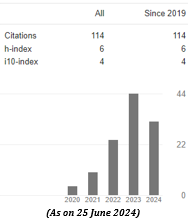A Novel Approach to Detect Cardiac Arrhythmia Based on Continuous Wavelet Transform and Convolutional Neural Network
Abstract
Electrocardiogram (ECG) signal is informative as well as non-invasive clinical tool to diagnose cardiac diseases of human heart. However, the diagnosis requires professionals’ clarification and is also time-consuming. To make the diagnosis proficient, a novel convolutional neural network (CNN) has been proposed for automatic arrhythmia detection. In this work, the ECG data collected from the MIT-BIH database have been preprocessed, and segmented in short ECG segments of 60 s. Then, all these segments have been transformed into scalogram images obtained from time-frequency analysis using continuous wavelet transform (CWT). Finally, these scalogram images have been exploited as an input for our designed CNN classifier to classify cardiac arrhythmia. In this approach, the overall accuracy, sensitivity, and specificity are 99.39%, 98.79%, and 100% respectively. Proposed CNN model has significant advantages, and it can be used to differentiate the healthy and arrhythmic patients effectively.
Downloads
References
Acharya, U. R., Fujita, H., Lih, O. S., Hagiwara, Y., Tan, J. H., & Adam, M. (2017). Automated detection of arrhythmias using different intervals of tachycardia ECG segments with convolutional neural network. Information sciences, 405, 81-90.
Banerjee, S., & Mitra, M. (2013). Application of cross wavelet transform for ECG pattern analysis and classification. IEEE transactions on instrumentation measurement, 63(2), 326-333.
Brisk, R., Bond, R., Banks, E., Piadlo, A., Finlay, D., McLaughlin, J., & David, M. (2019). Deep learning to automatically interpret images of the electrocardiogram: Do we need the raw samples? Journal of electrocardiology, 57, S65-S69.
Chen, X., Wang, Y., & Wang, L. (2018). Arrhythmia recognition and classification using ECG morphology and segment feature analysis. IEEE/ACM transactions on computational biology bioinformatics, 16(1), 131-138.
De Bie, J., Martignani, C., Massaro, G., & Diemberger, I. (2020). Performance of seven ECG interpretation programs in identifying arrhythmia and acute cardiovascular syndrome. Journal of Electrocardiology, 58, 143-149.
De Chazal, P., & Reilly, R. B. (2006). A patient-adapting heartbeat classifier using ECG morphology and heartbeat interval features. IEEE transactions on biomedical engineering, 53(12), 2535-2543.
He, R., Liu, Y., Wang, K., Zhao, N., Yuan, Y., Li, Q., & Zhang, H. (2019). Automatic cardiac arrhythmia classification using combination of deep residual network and bidirectional LSTM. IEEE access, 7, 102119-102135.
Huang, J., Chen, B., Yao, B., & He, W. (2019). ECG arrhythmia classification using STFT-based spectrogram and convolutional neural network. IEEE access, 7, 92871-92880.
Huikuri, H. V., Castellanos, A., & Myerburg, R. J. (2001). Sudden death due to cardiac arrhythmias. New England Journal of Medicine, 345(20), 1473-1482.
Khorrami, H., & Moavenian, M. (2010). A comparative study of DWT, CWT and DCT transformations in ECG arrhythmias classification. Expert systems with Applications, 37(8), 5751-5757.
Li, Z., Zhou, D., Wan, L., Li, J., & Mou, W. (2020). Heartbeat classification using deep residual convolutional neural network from 2-lead electrocardiogram. Journal of electrocardiology, 58, 105-112.
Mendis, S., Puska, P., Norrving, B. e., & Organization, W. H. (2011). Global atlas on cardiovascular disease prevention and control: World Health Organization.
Mitra, S., Mitra, M., & Chaudhuri, B. B. (2006). A rough-set-based inference engine for ECG classification. IEEE transactions on instrumentation measurement, 55(6), 2198-2206.
Mohonta, S. C., & Ali, M. F. (2021). Cardiac Arrhythmia Diagnosis based on Features Extraction and Convolutional Neural Network from ECG Signals. Paper presented at the 2021 5th International Conference on Electrical Engineering and Information & Communication Technology (ICEEICT).
Mohonta, S. C., Motin, M. A., & Kumar, D. K. (2022). Electrocardiogram based arrhythmia classification using wavelet transform with deep learning model. Sensing Bio-Sensing Research, 100502.
Oh, S. L., Ng, E. Y., San Tan, R., & Acharya, U. R. (2018). Automated diagnosis of arrhythmia using combination of CNN and LSTM techniques with variable length heart beats. Computers in biology medicine, 102, 278-287.
Prabhakararao, E., & Dandapat, S. (2021). Multi-Scale Convolutional Neural Network Ensemble for Multi-Class Arrhythmia Classification. IEEE Journal of Biomedical Health Informatics.
Queiroz, J. A., Azoubel, L. M. A., & Barros, A. K. (2019). Support system for classification of beat-to-beat arrhythmia based on variability and morphology of electrocardiogram. EURASIP Journal on Advances in Signal Processing, 2019(1), 1-9.
Queiroz, J. A., Junior, A., Lucena, F., & Barros, A. K. (2018). Diagnostic decision support systems for atrial fibrillation based on a novel electrocardiogram approach. Journal of Electrocardiology, 51(2), 252-259.
Rubin, J., Parvaneh, S., Rahman, A., Conroy, B., & Babaeizadeh, S. (2018). Densely connected convolutional networks for detection of atrial fibrillation from short single-lead ECG recordings. Journal of electrocardiology, 51(6), S18-S21.
Wang, T., Lu, C., Sun, Y., Yang, M., Liu, C., & Ou, C. (2021). Automatic ECG classification using continuous wavelet transform and convolutional neural network. Entropy, 23(1), 119.
Though MIJST follows the open access policy, the journal holds the copyright of each published items.

This work is licensed under a Creative Commons Attribution-NonCommercial 4.0 International License.
















